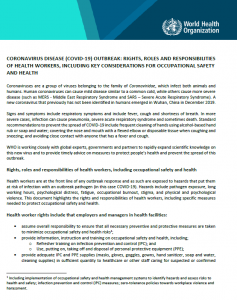
Coronaviruses are a group of viruses belonging to the family of Coronaviridae, which infect both animals and humans. Human coronaviruses can cause mild disease similar to a common cold, while others cause more severe disease (such as MERS – Middle East Respiratory Syndrome and SARS – Severe Acute Respiratory Syndrome). A new coronavirus that previously has not been identified in humans emerged in Wuhan, China in December 2019.
Signs and symptoms include respiratory symptoms and include fever, cough and shortness of breath. In more severe cases, infection can cause pneumonia, severe acute respiratory syndrome and sometimes death. Standard recommendations to prevent the spread of COVID-19 include frequent cleaning of hands using alcohol-based hand rub or soap and water; covering the nose and mouth with a flexed elbow or disposable tissue when coughing and sneezing; and avoiding close contact with anyone that has a fever and cough.
WHO is working closely with global experts, governments and partners to rapidly expand scientific knowledge on this new virus and to provide timely advice on measures to protect people’s health and prevent the spread of this outbreak.